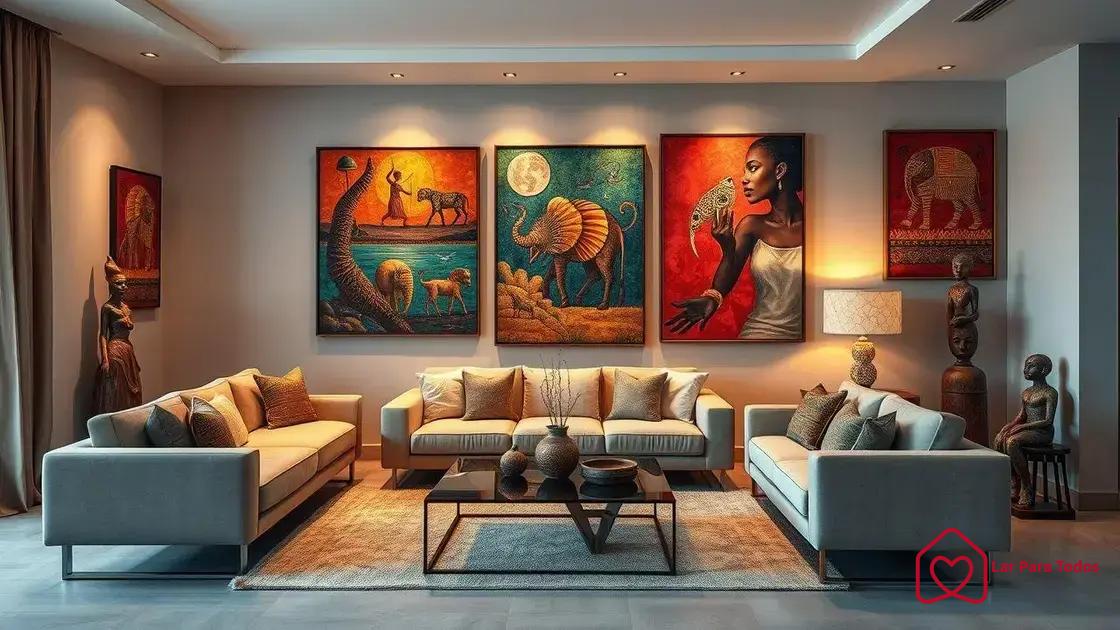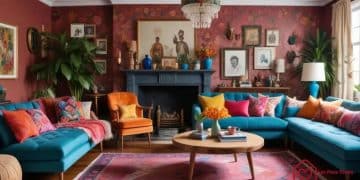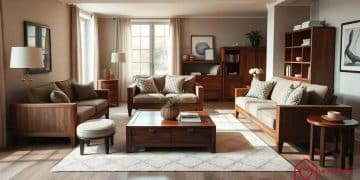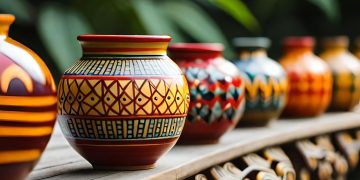Cultural specificity décor in South Africa: Unveiling unique styles

Looking to bring soul and identity into your space? Cultural specificity décor in South Africa offers a vibrant lens into the nation’s rich heritage, where every detail tells a deeper story.
From handwoven Zulu baskets to bold Ndebele patterns and Xhosa-inspired palettes, each element adds texture and meaning. These authentic touches go beyond style, they connect your home to centuries of cultural legacy.
Ready to embrace design that speaks? Step into a world where traditional craftsmanship meets modern aesthetics, and let South African culture shape your space in powerful, personal ways.
Understanding the essence of cultural décor in South Africa
To truly grasp the meaning behind Cultural specificity décor in South Africa, one must look beyond surface aesthetics. This design style is deeply rooted in storytelling, heritage, and ancestral memory.
Every pattern, artifact, and texture carries significance, echoing centuries of cultural expression shaped by the country’s diverse communities.
South Africa’s cultural décor is not defined by a single tradition but by the harmonious blending of multiple identities.
Whether it’s the bold geometry of Ndebele wall art or the earthy tones of Zulu beadwork, these expressions create immersive environments that are both modern and timeless. This dynamic fusion gives the décor its distinctive power and emotional depth.
When you embrace this approach, you’re not just styling a room, you’re connecting with layers of history, community, and meaning.
Each space becomes a canvas where personal style meets collective memory, resulting in an atmosphere that is uniquely South African.
Key Characteristics of Cultural Décor
A hallmark of Cultural specificity décor in South Africa is the unapologetic use of color and texture.
Rich ochres, deep blues, and vibrant reds are more than just design choices, they hold cultural significance, often linked to themes of protection, fertility, and spirituality. These palettes are paired with intricate patterns drawn from nature, mythology, and daily life.
Local craftsmanship shines through in handwoven textiles, carved wooden stools, and clay pottery that doubles as décor and storytelling medium. These materials don’t just enhance the ambiance; they anchor it in authenticity.
Each item, whether it’s a hand-stitched cushion or a sculpted animal figure, contributes to a narrative of pride, resilience, and celebration.
More than decorative, these elements carry emotional weight. A painted gourd might represent a rite of passage; a specific motif could honor ancestral lineage.
This spiritual layer transforms ordinary objects into cultural touchstones, deepening the meaning behind the space they inhabit.
Ways to Incorporate Cultural Décor
Bringing Cultural specificity décor in South Africa into your home can start with subtle, intentional choices. Instead of overhauling your entire space, integrate pieces that stand out for their history and symbolism.
A wall adorned with local textile art or a handmade basket from a rural co-op can immediately infuse authenticity.
Artistic curation plays a key role. Consider showcasing contemporary South African artists alongside traditional carvings to highlight the evolution of cultural identity.
Furniture made by local artisans adds another layer of depth, especially when it reflects regional techniques passed down through generations.
Ultimately, the goal is not to recreate a museum, but to invite culture into your everyday life. Let your space breathe with the stories, symbols, and soul of South Africa.
Through this thoughtful integration, your décor becomes a bridge, one that connects modern living to ancestral heritage in a way that’s both respectful and refreshingly original.
Key elements of South African cultural design
The heart of Cultural specificity décor in South Africa lies in its layered beauty, where tradition, symbolism, and innovation converge to create spaces full of meaning.
These design elements are more than visual accents; they carry emotional and cultural significance passed down through generations.
At the center of South African design is color. Bright blues, warm earth tones, and vivid reds are commonly used in textiles, beadwork, and ceramics. These bold palettes don’t just catch the eye, they reflect joy, resilience, and a celebration of life.
Color in South African décor is a storytelling tool, conveying values, emotions, and even social status through its placement and intensity.
This expressive use of color is complemented by careful attention to symmetry and composition. Interiors are designed not only for comfort but also for honoring ancestry, ritual, and a deep-rooted connection to community.
Every object, from a carved bench to a woven mat, adds to the cultural rhythm of the space.
Common Materials Used
Materials are the foundation of Cultural specificity décor in South Africa, serving as a direct link between the environment and artistic expression.
South African artisans traditionally work with what nature offers, not out of necessity alone, but out of a deep respect for the land and its resources.
Wood is often transformed into functional and decorative furniture using time-honored techniques. Each piece carries the markings of hand tools and personal craft, making it unique.
Clay is shaped into pots and sculptures that bridge form and function, often used in ceremonies and daily life alike.
Beadwork, long considered a sacred form of communication in many cultures, is not only worn but also incorporated into home items like cushions, lamps, and wall pieces.
These materials embody sustainable design long before it became a global trend. The process of gathering, crafting, and honoring raw elements is central to South African cultural aesthetics.
They infuse homes with authenticity and a tangible sense of place, turning everyday objects into vessels of cultural preservation.
Patterns and Motifs
Patterns and motifs in Cultural specificity décor in South Africa are rich with meaning, telling stories of lineage, community values, and spiritual beliefs.
From complex bead arrangements to geometric wall murals, each design holds purpose. These visual languages differ across cultural groups, yet all share a deep reverence for ancestral wisdom.
The iconic motifs of the Ndebele people, for example, use bold lines and symmetrical designs to signify identity and transformation. In contrast, Xhosa patterns are typically more minimalist, yet equally powerful in their symbolism.
These motifs appear in fabric, basketry, pottery, and even floor designs, embedding heritage into every corner of a home.
What makes these patterns especially powerful is their adaptability. While deeply rooted in tradition, they are often reimagined through contemporary formats, merging old and new into a cohesive whole.
This continuity ensures that cultural stories remain alive, even as lifestyles evolve. In South African design, patterns aren’t just decorative, they’re declarations of history, pride, and belonging.
Incorporating traditional art into modern spaces

Incorporating traditional art into modern spaces creates a unique blend of cultures, bringing warmth and personality to any environment. This fusion highlights the beauty of heritage while embracing contemporary design.
Many people find that traditional art offers a captivating story and an emotional connection. From handcrafted sculptures to vibrant paintings, these pieces can transform dull spaces into lively art galleries.
Selecting the right art is crucial in maintaining a balanced aesthetic. Consider the following tips when choosing traditional art for modern spaces:
- Consider Size: Larger pieces can be focal points, while smaller ones work well in groups.
- Color Palette: Ensure the colors complement your existing décor.
- Style Match: Mix traditional styles with modern elements to create harmony.
- Local Artists: Support local talent by incorporating pieces from nearby artisans.
As you blend these elements, you create a conversation around cultural significance. For instance, a striking South African tapestry can add depth to a minimalist room, making it feel welcoming and inviting.
How you display traditional art is just as important as the pieces themselves. Arranging art thoughtfully ensures that it stands out. Here are some effective strategies:
Creating a gallery wall allows you to harmoniously display multiple pieces, blending styles and narratives in a cohesive visual story.
A bold accent wall can serve as the perfect backdrop for traditional art, turning it into a powerful focal point that draws immediate attention.
For a more immersive experience, mixing different media, such as paintings, woven textiles, and handcrafted sculptures, adds depth and variety to the environment, showcasing the diversity of South African artistic expression.
Complementing these artworks with proper lighting is essential, as it enhances the colors, textures, and intricate details, bringing each cultural piece to life within the room.
Integrating traditional art into modern spaces can also inspire deeper connections. Sharing the stories behind the art invites guests and family members to engage with the culture.
By doing so, the space becomes more than just a room; it reflects a rich cultural heritage.
Ultimately, the successful combination of traditional art and modern design allows individuals to express their unique identities. Balancing these elements can create an inviting atmosphere that feels both familiar and fresh.
Exploring regional variations in décor styles
Exploring regional variations in décor styles across South Africa reveals a tapestry of vibrant cultures and traditions. Each region offers unique aesthetic elements influenced by its history, environment, and local communities.
For instance, in the coastal areas, you might find décor that reflects the ocean’s colors and textures. Bright blues and sandy tones dominate, often using natural materials like driftwood and sea glass.
The coastal homes often emphasize light and airiness, creating an inviting atmosphere.
Characteristics of Different Regions
Moving to the interior, one can observe how the landscape shapes the décor. In the arid regions, earthy tones and indigenous plants play a significant role in design.
Here are notable features from some key regions:
- Kwazulu-Natal: Known for its vibrant colors and patterns, emphasizing Zulu traditions.
- The Karoo: Features rustic charm with a focus on traditional stone and wood.
- The Cape Winelands: Blends elegant European influences with rustic farm aesthetics.
- The Eastern Cape: Showcases unique local craftsmanship in textiles and pottery.
The cultural heritage of South Africa enriches its designs with meaningful symbolism. For example, beadwork is not just decoration; it can signify status, community, or personal identity.
Incorporating these thoughtful elements into any space brings a deeper connection to the culture.
Modern Influence on Traditional Styles
As urban areas grow, modern design trends are melding with traditional styles. This fusion creates spaces that honor heritage while embracing contemporary preferences.
Furniture made from local materials blends seamlessly with modern styling, offering both comfort and cultural authenticity.
For decoration, mixing traditional crafts with sleek lines can rejuvenate a space while maintaining cultural integrity. A modern chair paired with a traditional woven rug exemplifies this beautiful contrast, inviting an appreciation for both styles.
Visiting different regions and understanding their distinct décor styles provides inspiration for anyone looking to decorate their home.
It allows you to create a personal space that reflects not only your taste but also a connection to South Africa’s rich cultural diversity.
Tips for blending cultural elements into your home
Blending cultural elements into your home can create a unique and inviting atmosphere that celebrates diversity. To achieve this, consider using a mix of styles, colors, and textures that reflect your heritage or interests.
Start by identifying key pieces that resonate with you. Whether it’s a traditional artifact, artwork, or textile, these items serve as focal points in your space.
Integrating them thoughtfully makes a strong statement and adds character to your home.
Practical Tips for Integration
When incorporating Cultural specificity décor in South Africa into your space, begin by choosing a color palette that complements your existing interior while allowing cultural elements to stand out.
The right tones can unify the room and emphasize the richness of traditional pieces without overwhelming the space.
Blending modern furnishings with heritage items creates an eclectic, balanced look that feels both contemporary and deeply rooted in culture.
By layering textures, combining materials like carved wood, woven fabrics, and metal accents, you add visual depth and tactile interest that reflect the diversity of South African design.
Equally important is focusing on functionality. Decorative items should not only enhance the aesthetic but also serve a practical role in daily life.
This approach ensures that your space remains both meaningful and livable, harmonizing beauty with purpose.
Personalizing your space with cultural elements fosters a sense of warmth and connection. For instance, a beautifully woven basket can be both a decorative item and a storage solution.
Creating Visual Balance
When blending cultures, it’s important to maintain visual balance. Too many contrasting styles can overwhelm a space. Aim to create a cohesive environment where cultural elements complement each other.
This can be done by repeating colors or patterns throughout your home.
Consider displaying cultural art pieces in groupings to create visual interest. For instance, a gallery wall featuring different artworks allows you to showcase diverse styles while maintaining a unified look.
Choose frames that match to tie everything together seamlessly.
Incorporating cultural elements into your home isn’t just about aesthetics; it’s a way to celebrate your identity and experiences.
By thoughtfully choosing and blending these items, you can create an inviting environment that speaks to your story and values.
By blending cultural elements into your home, you invite a world of stories and diversity into your everyday environment. This fusion not only enhances your space but also fosters an appreciation for various traditions and histories.
Whether you’re incorporating traditional art, textiles, or unique artifacts, each piece contributes to a rich tapestry that reflects who you are.
Remember to maintain balance and harmony in your design to create an inviting atmosphere. With these tips, your home will celebrate both your personal style and the beautiful cultures around you.
Did you like the content? Visit our website and read it too: Interior design books: Timeless resources for all styles and skill levels.
FAQ – Frequently Asked Questions about Blending Cultural Elements into Your Home
How can I start incorporating cultural elements into my home?
Begin by selecting key pieces that resonate with you, like artwork, textiles, or artifacts, to serve as focal points in your decor.
What types of cultural items work best in modern homes?
Traditional art, handcrafted furniture, and vibrant textiles can all enhance modern spaces while adding character and warmth.
Are there specific color palettes to consider when blending styles?
Yes, choose colors that complement your existing décor and highlight your cultural pieces to create a harmonious look.
How can I maintain balance when mixing different styles?
Focus on visual balance by using repeating colors or patterns and ensuring that different pieces coordinate with one another.





